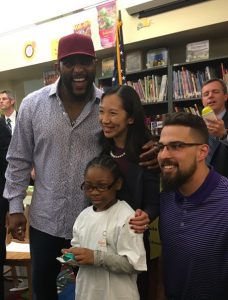By Leana S. Wen, MD, MSc, Health Commissioner of Baltimore City
Founded in 1793 in response to a yellow fever outbreak, the Baltimore City Health Department (BCHD) is the oldest continuously-operating health department in the country. For over two centuries, BHCD’s mission has been to improve the health and well-being of Baltimore residents while advocating for equity and justice. Public health has never taken a back seat in Baltimore, and our vision for Public Health 3.0 has five unique components to address the most pressing health needs of our city.

First, we are the citywide convener to set shared health priorities and strategies. In 2009, Baltimore had one of the worst infant mortality rates in the United States. BCHD led a coalition of 150 public and private partners, including hospitals, clinics, foundations, sororities, and churches, to found a program called B’More for Healthy Babies. Aligned to one goal, one evidence-based strategy, and one shared outcome, within six years, Baltimore’s infant mortality rate dropped by 28 percent. The number of infants dying in their sleep was reduced by half. The disparity between black and white infant deaths dropped by 40 percent.
Second, we go to where people are. Until last month, children were only getting eye screenings in their schools in pre-kindergarten, first, and eighth grades. Less than 20 percent of kids who screened positive were getting glasses, resulting in thousands of children being held back in school and potentially labeled as being disruptive when all they needed was a simple intervention of glasses. Together with our partners at Johns Hopkins University and the support of local foundations, we launched Vision for Baltimore, which will provide eye screenings and glasses, free of charge, in their schools, for every child in every grade, kindergarten through eighth, so that they don’t have to miss class and their caregivers don’t have to miss work.
Third, we change legislation and save lives. Addiction is a huge problem in Baltimore. There are over 20,000 people who use heroin. More people die from overdose than die from homicide, so I declared overdose to be a public health emergency. We passed legislation so that, as of October 1, 2015, I became the single prescriber of the opioid antidote, naloxone, to all 620,000 residents. We believe that every resident can save a life, so we began doing trainings across the city. We partnered with other city agencies, businesses, community groups, and faith leaders to provide trainings in markets, churches, senior housing, jails, bars and restaurants, even the zoo. Since 2015, we’ve trained over 11,000 people on how to save a life in community trainings, and developed the first-of-its-kind online naloxone training platform, DontDie.org.
Fourth, we protect the most vulnerable. In the unrest following Freddie Gray’s death last April, over a dozen pharmacies were burned down, looted, or closed. We heard about seniors and other vulnerable individuals who didn’t have access to medical care and to life-saving medications, so we arranged transportation to hospitals. We figured out who needed what medications how urgently—and delivered them to their homes. We organized food distribution and set up a shuttle for seniors to get groceries. Our efforts have continued, with virtual supermarkets to keep on delivering healthy food to people who do not have access to them, and a 24/7 phone hotline for individuals seeking addiction and mental health help.
Finally, we incorporate health-in-all policies across the city. For example, we see violence prevention as a health issue. Through our Safe Streets program, where we partner with community-based organizations to hire recently released citizens, many of whom are former gang members and drug dealers. These workers walk the streets of Baltimore and interrupt violence where they see them. Last year, our Safe Streets workers mediated nearly 700 conflicts, and the majority of these interactions were deemed to be likely, or very likely, to reduce gun violence.
Our history, mandate, and these guiding principles define Public Health 3.0 for Baltimore City. The context of our city is unique, but the problems we address on a daily basis – the opioid epidemic, obesity, food access, lead poisoning, and rampant disparities – are issues that touch every city in America. This is the necessary role of local public health: to go to where people are, to bring the community together, and to respond to their needs. But unlike in years past, we can no longer think of health as the absence of disease. Nor is health equivalent to the health care delivered in hospitals. Instead, through Public Health 3.0, we can aspire to create well-being in all of our communities and ensure that everyone can reach their full potential.
For more information, follow @BMore_Healthy and @DrLeanaWen.